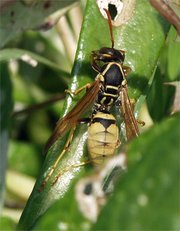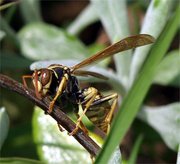Wasp
|
|
| Wasps | ||||||||||||
|---|---|---|---|---|---|---|---|---|---|---|---|---|
| Aleiodes indiscretus parasitizing gypsy moth caterpillar. | ||||||||||||
| Scientific classification | ||||||||||||
| ||||||||||||
| Families | ||||||||||||
|
See text. |
A wasp is any insect of the order Hymenoptera and suborder Apocrita that is not a bee, sawfly, or an ant. Less familiar, the suborder Symphyta includes the sawflies and wood wasps, which differ from the Apocrita by having a broad connection between the thorax and abdomen.
The various species of wasps fall into one of two main categories: solitary wasps and social wasps. Adult solitary wasps live and operate alone, and most do not construct nests (below); all adult solitary wasps are fertile. By contrast, social wasps exist in colonies numbering up to several thousand individuals and build nests—but in some cases not all of the colony can reproduce. In some species, just the wasp queen and male wasps can mate, whilst the majority of the colony is made up of sterile female workers.
Generally, wasps are parasites or parasitoids as larvae, and feed on nectar only as adults. Many wasps are predatory, using other insects (often paralyzed) as food for their larvae. In parasitic species, the first meals are almost always derived from the host in which the larvae grow.
Several types of social wasps are omnivorous, feeding on a variety of fallen fruit, nectar, and carrion. Some of these social wasps, such as yellow jackets, may scavenge for dead insects to provide for their young. In many social species, the larvae provide sweet secretions that are consumed by adults. Adult male wasps sometimes visit flowers to obtain nectar to feed on in much the same manner as honey bees.
| Contents |
Characteristics
The following characteristics are present in most wasps:
- Two pairs of wings (exception: female Mutillidae)
- A stinger (only present in females because it derives from the ovipositor)
- Few or no hairs (in contrast to bees); exception: Mutillidae
- Predators or parasitoids, mostly on other insects; some species of Pompilidae, such as the tarantula hawk, specialize in using spiders as a host
Wasps are critically important in natural biocontrol. Almost every pest insect species has a wasp species that is predator or parasite upon it. Wasps are also increasingly used in agricultural pest control.
Mud daubers are a common species of wasp.
Families
- Vespidae - yellowjackets, hornets, paper wasps.
- Scoliidae - Scoliid wasps
- Mutillidae - velvet "ants"
- Sphecidae - digger wasps, e.g. the Cicada Killer Wasp
- Pompilidae - spider wasps
- Chrysididae - cuckoo wasps
- wood wasps - feeding on dead wood
Clipart and Animal Pictures
- Clipart (https://classroomclipart.com/image/category/clipart.htm)
- Animal Clipart (https://classroomclipart.com/image/category/animal-clipart.htm)
- Animal Animated Clipart (https://classroomclipart.com/clipart/Animations/Animals.htm)
- Pictures of Animals (https://classroomclipart.com/image/category/animal-photos.htm)
- Amphibian Clip Art, Pictures and Photogaphs (https://classroomclipart.com/image/category/amphibian-clipart.htm)
- Farm Animal Clip Art, Pictures and Photographs (https://classroomclipart.com/image/category/farm-animal-clipart.htm)
- Mammal Clip Art, Pictures and Photographs (https://classroomclipart.com/image/category/mammal-clipart.htm)
- Marine Animal Clip Art, Pictures and Photographs (https://classroomclipart.com/image/category/marine-life-clipart.htm)
- Reptile Clip Art, Pictures and Photographs (https://classroomclipart.com/image/category/reptile-clipart.htm)
- Spider Clip Art, Pictures and Photographs (https://classroomclipart.com/image/category/spider-clipart.htm)
- Picture of Wasps (http://classroomclipart.com/cgi-bin/kids/imageFolio.cgi?direct=Animals/Insects/Wasps)




